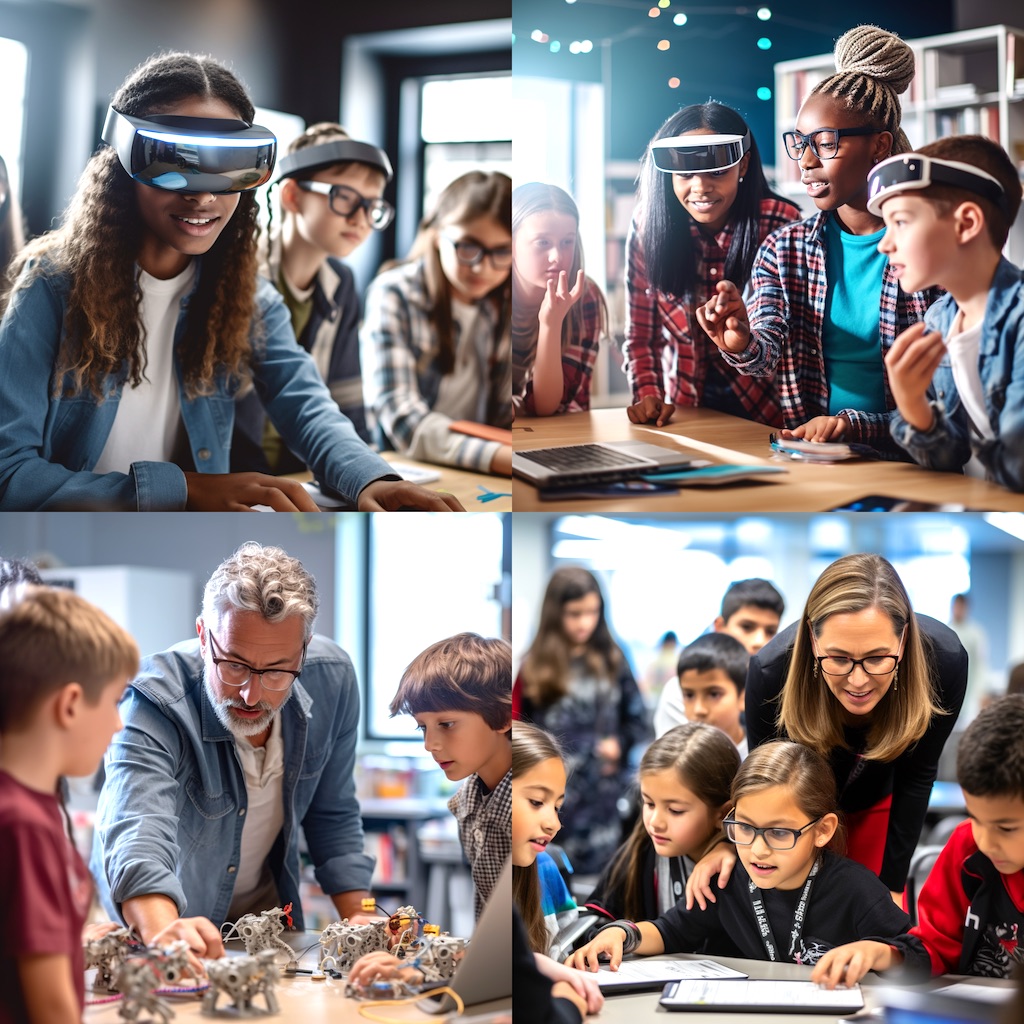Learning to Teach with AI a Small Bite at a Time
Shawn McCusker, a former teacher and school administrator, is the senior director of professional learning at EdTechTeacher.
The old joke “What’s the best way to eat an elephant?” accurately sums up an effective strategy for navigating the roiling modern world of Artificial Intelligence.
The rollout of new AI tools has been so fast-paced that it is hard to keep up with every one of the tools that enters the market. My personal list fizzled out once it reached 120 tools and when I had the realization that AI will be everywhere.
Trying to track it was like counting raindrops in a rainstorm. It would be easier to list the platforms that are not using AI tools than the ones that are.
Suddenly, AI matters a lot
The AI shockwaves across the world have been palpable, leading people to question the effects on equity, education, the economy, and more or less everything.
An article in Science magazine recently announced that fearful tech leaders are calling for an AI research pause, in order to “formulate safeguards to protect society from potential risks” – while others are pushing back, saying that AI can create a more accurate, efficient, and sustainable world.
When I say “others” I include ChatGPT itself. When I asked, “What are some of the societal benefits of using AI tools?” the platform offered seven (arguable) positive impacts. It also cautioned that “(e)thical considerations, such as fairness, transparency, and accountability, need to be carefully addressed to ensure that AI systems benefit everyone and do not perpetuate bias or harm.” See the full response here.
As educators, we are often thrust into the middle of societal controversies, cultural divides, and rapid change and forced to navigate carefully to serve the needs of our students. This process can be stressful and overwhelming.
A recent poll showed that currently 70% of teachers have received no faculty guidance on the use of AI like ChatGPT. Gaining enough mastery of AI to integrate it into lesson planning can be daunting. It might be best to consider the elephant joke when strategizing how to figure out AI – one bite at a time. And start with small bites.
Begin your exploration with a few topics
If you are an educator trying to explore what AI can do without diving into the global implications of the technology, start small and look for simple ways to probe the implications of AI. These may include topics like academic integrity, accuracy and reliability, and how AI can save time – a precious and hard-to-come-by resource in education.
Jot down the questions you’re wondering about and start looking for answers. You won’t be surprised to learn that the internet is already full of ‘what’ and ‘how-to’ AI information, including lots of articles by educators. Here are some steps you might take as you begin exploring.
► Start small by using embedded AI tools in existing applications. The potential for content creation using AI tools is a positive one. By engaging with these tools, teachers can begin to understand what AI is and isn’t and gain familiarity. Here are two:
Formative, an online instruction and assessment platform, has an “AI Generate Feature” that takes your grade level and topic to quickly generate a quiz complete with learning objectives and detailed instructions. On a smaller scale, you can use AI to generate individual questions.
Flip(grid) offers an AI topic generator that can give you discussion prompts aimed at specific subjects and grade levels. Then with a click, you can add them to your class discussions. Very simple, and very efficient.
► Curious about AI used for differentiation? Take a look at Duolingo. This language learning app uses AI to adjust learning based upon student performance, allowing learners to move at their own pace. Even if you don’t want to learn a language, exploring Duolingo might help prepare you for the future of differentiated learning.
► AI media creation has generated a lot of buzz. AI Video and Audio editors are likely to be commonplace in the near future. I asked Canva to create a landscape image of Chicago in the style of the artist Magritte and you can see the result below.
Similar AI-based tools like Adobe Firefly are available for exploration; many are still in beta testing and require a short wait to join and/or get a subscription. Adobe does offer some helpful AI tools for free. For example, Adobe Express has an Image Background Remover that instantly performs a task that used to be long and arduous.
► Focus on Critical Thinking around the ethics of AI. Sometimes we are tempted to think of a technology as either “good” or “bad,” but in practice anything powerful can be powerfully good or powerfully bad depending on how we choose to use it. Those choices need to be informed and navigated.
Our students will need frameworks to determine prosocial versus anti-social uses of the technology. We can serve them well by diving into these topics. Help them understand where AI exists (everywhere from Netflix to Gmail), the biases it contains, and how these biases can influence our thinking and attention.
Also take time to discuss the privacy implications of these tools and how they are using and keeping our data. The MIT Media Lab developed a model AI Ethics Curriculum for middle schools in 2019. It includes activities for understanding Algorithmic Bias and Algorithms as Opinions.
The curriculum’s “Ethical Matrix” activity discusses stakeholder values and how they affect algorithmic outcomes. Another lesson discusses classification and the problems that creating AI classifications produce. This is a good place for you to envision what teaching these topics might look like.
► Learn about the importance of AI “prompts.” Once you are ready to dive into ChatGPT you will realize that “prompt engineering” (writing effective prompts) is an important part of using AI effectively.
The Snack Prompt platform archives and categorizes popular prompts by topic and has a tool for personalization. This site can move you from toying with simple basic AI tools to a greater understanding of the level of complexity that is possible with high-quality AI.
ABOVE: A 4-image set created in the Midjourney AI app using this prompt from Snack Prompt/ChatGPT: “A dedicated and inspiring teacher using innovative technology in the classroom, surrounded by excited students, capturing the integration of education and digital tools and AI, vibrant colors.”
Use a spoon, not a shovel
Spend some time this summer exploring AI. Take it slow. AI may yet change the world, but if we try to process all of its implications in one big gulp, it can be overwhelming. We don’t need to bear the full weight of AI’s potential impacts just yet. For now, we can serve our students well by developing a foundational understanding of the technology, one small bite at a time, so that we are better prepared to guide our students into the future.
References
“Alarmed tech leaders call for AI research pause: As systems dazzle, researchers worry about lack of safeguards and regulation.” Science. American Association for the Advancement of Science. 11 Apr. 2023.
“ChatGPT in the classroom: Here’s what teachers and students are saying.” USA Today. 1 Mar. 2023.
Overview: AI + Ethics Curriculum for Middle School. MIT Media Lab. Accessed 18 May. 2023.
Feature image: Midjourney AI
Shawn McCusker (@shawnmccusker) is Senior Director of Professional Learning at EdTechTeacher, a leading edtech professional learning provider in the United States. Shawn has 25 years of experience as a teacher and leader in public, private, and alternative schools. He is co-author of Becoming Active Citizens: Practices to Engage Students in Civic Education Across the Curriculum (Solution Tree, 2022). His 2023 summer workshop for edtech.org will explore “Powerful Learning Experiences with Augmented and Virtual Reality.”





































